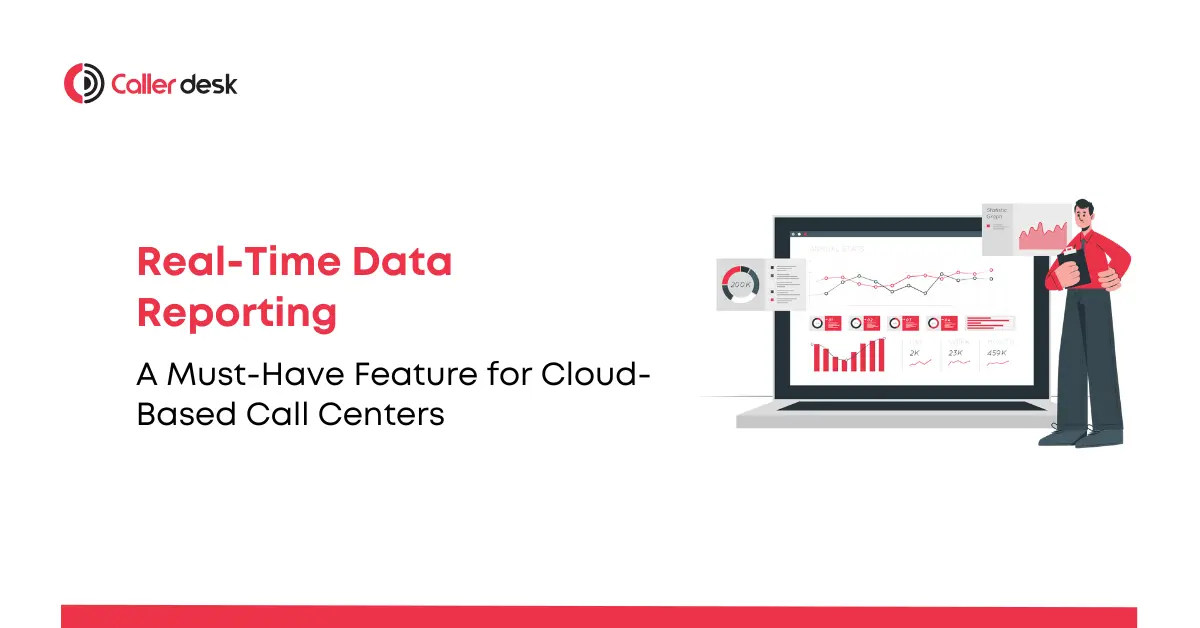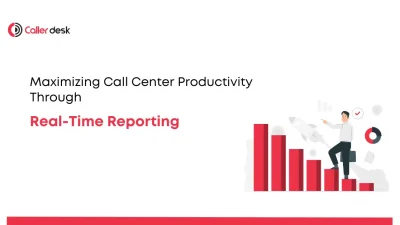How do some businesses consistently deliver outstanding customer service while staying ahead of their competition? Their secret often lies in leveraging modern tools and technologies to streamline operations and enhance customer experiences.
Among these tools, real-time data reporting has emerged as a game-changer for cloud-based call centers. By providing instant insights into key metrics, this feature empowers managers and agents to make data-driven decisions, improve efficiency, and deliver exceptional service at every touchpoint.
In this blog, we’ll explore what real-time data reporting entails, why it’s a must-have feature for call centers, and how it can help businesses unlock their full potential.
What is Real-Time Data Reporting?
Real-time data reporting refers to the ability to access, analyze, and act on live data from call center operations as events occur. Unlike traditional reporting systems that rely on historical data, real-time reporting gives managers instant visibility into key metrics, including:
- Call volumes: How many calls are being handled at any given time?
- Agent availability: Which agents are free, busy, or unavailable?
- Customer satisfaction levels (CSAT): Are interactions meeting customer expectations?
- Average handling times (AHT): How efficiently are agents resolving customer queries?
- First call resolution (FCR): How often are issues resolved during the first interaction?
With this live information at their fingertips, supervisors can identify bottlenecks, make quick adjustments, and ensure seamless operations—all while improving customer satisfaction.
Key Benefits of Real-Time Data Reporting
1. Enhanced Agent Productivity
Real-time data empowers managers to monitor agent performance throughout the day. With insights into call volumes, response times, and resolution rates, managers can:
- Spot productivity gaps immediately.
- Deliver targeted coaching to underperforming agents.
- Distribute workload efficiently to prevent burnout.
For instance, if an agent is struggling with long handling times, managers can provide immediate feedback or assign simpler tasks to balance workloads. This proactive approach keeps agents motivated and ensures optimal performance.
2. Improved Customer Satisfaction
In today’s fast-paced world, customers expect quick and effective service. Real-time data reporting enables call centers to:
- Identify and resolve issues during live interactions.
- Reassign resources to minimize wait times.
- Monitor customer sentiment in real-time, allowing managers to intervene when necessary.
By addressing customer concerns promptly, businesses can create positive experiences that foster trust, loyalty, and long-term relationships.
3. Reduced Operational Costs
Efficient resource management is key to reducing costs in a call center. Real-time reporting helps achieve this by:
- Optimizing workforce scheduling to prevent overstaffing or understaffing.
- Reducing idle time by balancing workloads across agents.
- Lowering the risk of lost opportunities due to dropped calls or escalations.
For example, during peak hours, real-time data can alert managers to increase staffing levels, ensuring that every customer inquiry is addressed without delays.
4. Superior Call Quality
Real-time data reporting allows managers to monitor and maintain call quality standards by tracking metrics like:
- First-call resolution (FCR): The percentage of issues resolved on the first attempt.
- Average speed of answer (ASA): How quickly agents respond to incoming calls.
- Call abandonment rate: The percentage of customers who hang up before speaking to an agent.
With these metrics, managers can identify recurring issues, revise scripts, and offer on-the-spot training to ensure every customer interaction meets or exceeds expectations.
5. Actionable Insights for Continuous Improvement
Beyond tracking metrics, real-time reporting provides actionable insights into call center operations. By analyzing emerging patterns and trends, businesses can:
- Identify top-performing agents and replicate their best practices across the team.
- Pinpoint inefficiencies in workflows and streamline processes.
- Adjust strategies in response to customer feedback and evolving needs.
These insights create a feedback loop that drives continuous improvement and helps call centers stay ahead of the curve.
6. Improved Compliance and Security
Compliance with industry regulations is non-negotiable for businesses in sectors like healthcare, finance, and telecommunications. Real-time reporting helps call centers:
- Monitor compliance with data security protocols and regulatory requirements.
- Generate immediate alerts for potential violations, enabling quick corrective actions.
- Ensure that sensitive customer information is handled responsibly and securely.
By prioritizing compliance, call centers can build customer trust while mitigating legal and reputational risks.
7. Faster Decision-Making
In the dynamic environment of a call center, delays in decision-making can lead to lost opportunities. Real-time reporting equips managers with the tools to:
- Make swift, informed decisions based on live data.
- Adapt to sudden changes, such as unexpected spikes in call volumes.
- Respond to customer needs in real-time, enhancing their overall experience.
Getting Started with Real-Time Data Reporting
Implementing real-time reporting in your call center is easier than you think. Here’s how to get started:
1. Choose the Right Software
Select a cloud-based call center solution like CallerDesk that offers robust real-time reporting features. Ensure the software integrates seamlessly with your existing systems and supports your business goals.
2. Leverage Built-In Dashboards
Utilize built-in reporting dashboards to track essential KPIs like CSAT, FCR, and AHT. These tools provide a clear view of performance metrics, helping managers identify areas for improvement.
3. Train Your Team
Equip your managers and agents with the knowledge to interpret and act on real-time data. Regular training sessions ensure they can make the most of the reporting tools and turn insights into actionable strategies.
4. Integrate Advanced Analytics
For deeper insights, integrate third-party analytics solutions to visualize trends and uncover opportunities for growth. Advanced tools can reveal patterns that drive smarter decision-making.
Why Choose CallerDesk for Real-Time Reporting?
CallerDesk is a trusted partner for businesses looking to elevate their call center operations. With cutting-edge features like:
- Live Dashboards: Get instant updates on agent performance, call quality, and customer satisfaction.
- AI-Powered Analytics: Analyze customer sentiment, predict trends, and optimize workflows.
- Scalability: Easily adapt to changing business needs with flexible and scalable solutions.
- CRM Integration: Access customer data in real-time to personalize interactions and enhance efficiency.
- Compliance Monitoring: Ensure adherence to industry regulations with robust security features.
Conclusion
Real-time data reporting isn’t just a feature—it’s a necessity for call centers aiming to deliver world-class service while maintaining operational efficiency. By offering live insights into performance metrics, real-time reporting empowers businesses to make informed decisions, enhance agent productivity, and exceed customer expectations.
If you’re ready to unlock the full potential of real-time reporting, CallerDesk has the tools you need to succeed. From live dashboards to AI-driven analytics, our solutions are designed to help you stay ahead in today’s competitive landscape.
Schedule a free demo with CallerDesk today and discover how our advanced reporting features can transform your call center operations.
Frequently Asked Question
1. What is real-time data reporting in cloud-based call centers?
Real-time data reporting allows call center managers to access and analyze live metrics, such as call volumes, agent availability, and customer satisfaction levels, as they occur. This enables managers to make instant, informed decisions to enhance customer service and operational efficiency.
2. How does real-time reporting improve agent productivity?
Real-time dashboards provide insights into agent performance metrics like average handling time, resolution rates, and call volumes. These insights help managers identify gaps, provide immediate feedback, and allocate tasks efficiently, ensuring agents focus on priority calls and improve their overall productivity.
3. Can real-time data reporting help reduce call center costs?
Yes, real-time reporting optimizes resource management by preventing overstaffing or understaffing. By monitoring call demand and adjusting schedules, call centers can minimize idle time, reduce operational inefficiencies, and save costs without compromising service quality.
4. How does real-time reporting enhance customer satisfaction?
By offering instant visibility into customer interactions and sentiment, real-time reporting enables managers to address issues during live calls, reallocate resources to reduce wait times, and provide timely resolutions. This proactive approach ensures a better customer experience.
5. What are the key metrics tracked in real-time reporting?
Key metrics include:
Call volumes
Agent availability
First call resolution (FCR) rates
Average handling time (AHT)
Customer satisfaction scores (CSAT)
Call abandonment rates
6. What tools are required for effective real-time reporting?
A robust cloud-based call center platform like CallerDesk is essential. It offers features like live dashboards, AI-powered analytics, CRM integrations, and real-time alerts to ensure seamless operations and better decision-making.
7. Is real-time reporting suitable for small businesses?
Yes, real-time reporting benefits businesses of all sizes. For small businesses, it ensures resource optimization, efficient workforce management, and improved customer satisfaction, all of which are critical for growth and competitiveness.
8. How does real-time reporting ensure compliance in regulated industries?
Real-time reporting helps monitor agent adherence to regulatory guidelines and data security protocols. Instant alerts for potential violations allow managers to take corrective action promptly, ensuring compliance and protecting sensitive customer information.
9. Can real-time reporting be integrated with other tools?
Yes, advanced call center solutions like CallerDesk can seamlessly integrate with CRM systems, workforce management tools, and third-party analytics platforms. This ensures a unified system that enhances efficiency and data-driven decision-making.
10. What makes CallerDesk the best choice for real-time reporting?
CallerDesk offers a comprehensive real-time reporting solution that includes:
Live performance dashboards
AI-powered sentiment analysis
CRM and third-party integration capabilities
Flexible scalability for growing businesses
Advanced compliance monitoring tools





